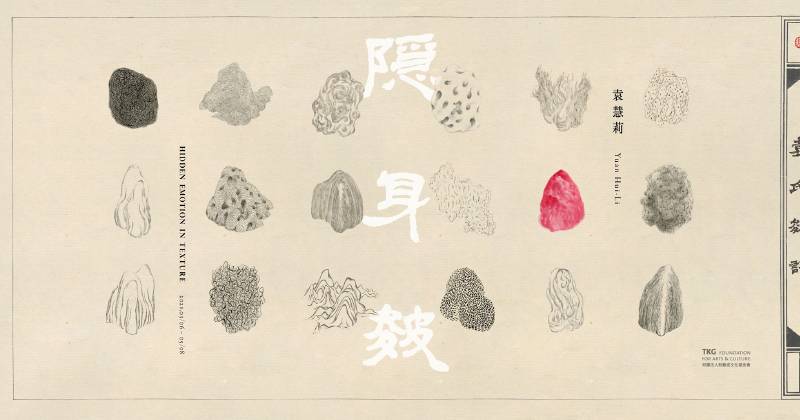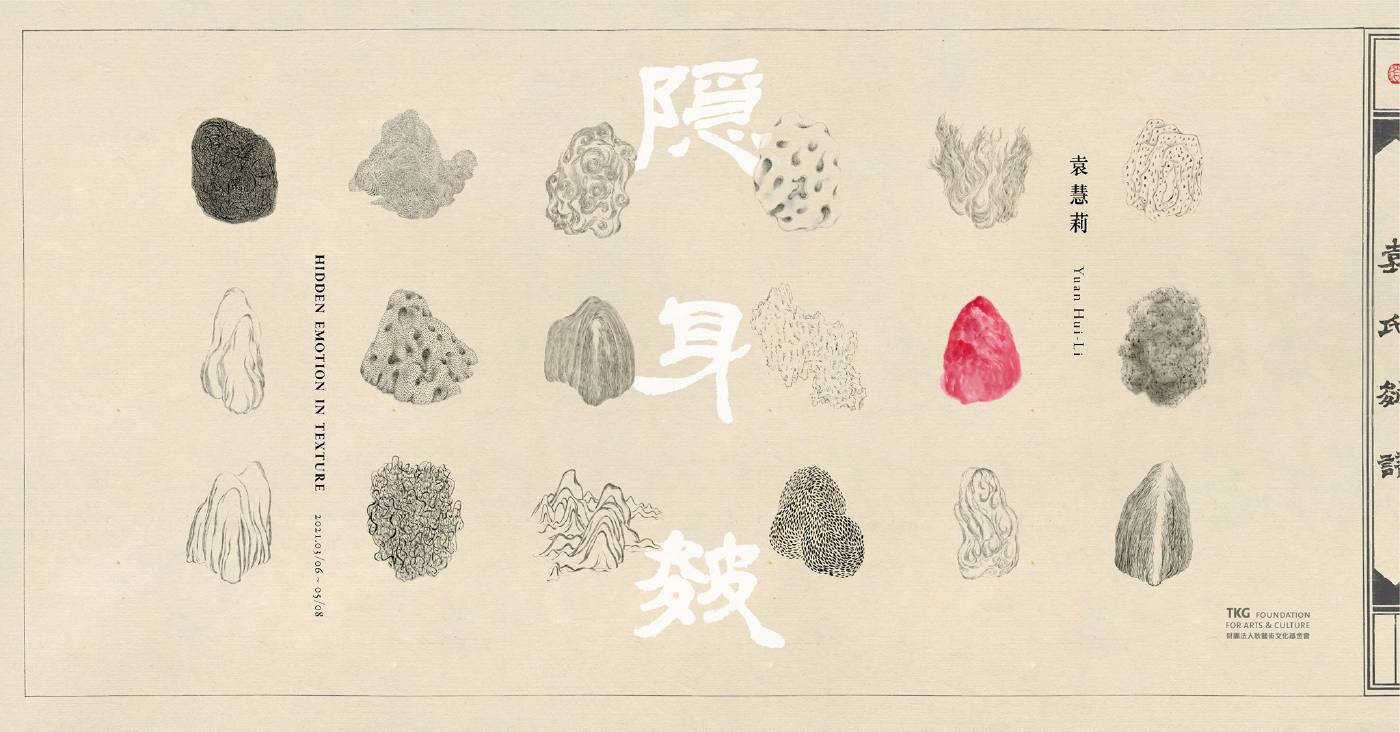耿畫廊
【隱身皴】袁慧莉個展

-
展期
日期:2021-03-06 ~ 2021-05-08
-
地點
台北市11492內湖區瑞光路548巷15號地下一樓
-
參展藝術家
袁慧莉
-
隱身皴:袁慧莉個展
展期 │ 2021.03.06 – 2021.05.08
開幕 │ 2021.03.06 (六) 下午4:30
地點 │ 耿畫廊 (台北市11492內湖區瑞光路548巷15號地下一樓)
2021年開春第一檔,耿畫廊將於地下一樓展廳,推出袁慧莉歷經四年苦心孤詣完成的《隱身皴》新作個展。
「皴法」是中國水墨畫中最重要的造型元素,也是現代水墨畫運動革新中主訴對象,皴法從古典水墨的筆墨技法到現代水墨強調物性肌理,還能如何再推進其形式意涵? 此次袁慧莉以「皴法」為題,將展示其花費十餘年深入思考的創作成果。
袁慧莉認為,從格物致理的五代宋朝,發展到側重筆墨意趣的元明清,乃至現代水墨畫新技法下的皴法,不論其型態筆墨變化如何,不論形似或不似,皴法的符徵或符旨,被指涉於或附屬於自然山石肌理的形意語法範疇,歷來並不曾改變,也就是說,皴法未曾被獨立地觀看。
同時,袁慧莉從女性主體意識出發,觀察到中國山水畫是以男性主體為主所建構的歷史,女性畫家往往依附在男性主導的水墨論述與形意體系中,這個體系向來欠缺女性主體意識自身發展的形意語境。
那麼如何置入女性主體意識於皴法中?並且改變原本皴法只作為指涉自然的形意詮釋規律?這兩個提問促使她十餘年來不斷透過《太虛》系列、《類山水》系列進行探索研究,最終在《袁氏皴譜》完成她所追索的答案。
饒富意味的是,這樣的追索過程與袁慧莉個人生命的歷程緊緊扣合,她將自己在情感上的經歷與對歷史的叩問結合。《類山水》(原名《太虛》系列)的發生,正是源於2007年個人情感上的極大挫折,促使她投身於山水畫的自我療癒之中。然而,當她發現過往水墨既有的皴法點線造形與詮釋語法,與其個人內在情緒的抒發,有著極大差距與隔閡,無法真實傳達自身內在感覺時,她開始思索如何將那些飽脹的情緒轉化為點線,使思念如絲線纏繞編織、借點寓淚、借線燃燒內心的糾結、怒火…甚至因憂惱而致心律不整,到醫院檢查看到高高低低的心電圖,也被她化為「心律皴」,《類山水》畫中那看似山谷的造型,其實隱喻的正是個人身體的情緒反應。可以說,《類山水》的皴法造型,是不可見的心理肌理被她顯現為可見的情緒皴法。
袁慧莉在不斷透過《太虛系列》、《類山水》系列自我治療的十餘年時間,她將各種情緒轉化為各式點線皴法,最後挑選其中三十二式造型集結成《袁氏皴譜》。《袁氏皴譜》挪用《芥子園畫譜.山石譜》形式,進行圖文顛覆,打破傳統皴法家派的法則規律,以女性陰性書寫建構當代新的皴法詮釋。將女性主體置入其中,透過「皴法」的形意變異,改變歷史修辭,完成另一項山水畫語言的當代轉化。
此次展場除將展示《袁氏皴譜》二十件全開原作,並以原作藝術微噴成小尺幅的《袁氏皴譜》版畫線裝書,而每一版次的線裝書中均附有一件小尺幅的《類山水》原作。
袁慧莉早自1992年便已開始從水墨的材質物性出發,發展出《孤山水》的拼組塊狀結構風格,本展中,她延續此風格,提出幾件過去未曾使用在油畫布上的《勢山水》拼貼新作,以作為《類山水》塊狀結構創作脈絡的對照。《勢山水》以無目的且自由的筆墨塗鴉,彰顯出宣紙自身物性的墨色肌理,再將宣紙撕成斷片,重新拼組成看似山水的塊狀結構,這些原本無目的的肌理因此轉變成皴塊。她以塊片模件拼組的創作方式,是為了尋找「自由」與「控制」兩種不同力場的拮抗關係,這種差異並置的拮抗關係,使得皴塊墨色斷片之間產生某種難以言喻的內在之勢。
袁慧莉喜歡利用差異並置的拮抗關係,製造連續與不連續之間的曖昧結構,《類山水》作品延續其一貫塊狀拼組的創作方式,但不同於墨塊分離的《勢山水》,繁複重色的《類山水》則是將各式差異的皴塊並置佈局,這種「差異並置」的塊狀皴結構,使畫面具有混雜而多元的樣貌,也迥異於傳統山水畫常以統一調性皴法整合畫面的運用方式。袁慧莉認為,傳統封建帝國時代下的山水畫,習慣以單一皴法營造統一和諧的理想感,而《類山水》運用差異皴塊並置的混雜樣式,則反應了當代多元混雜、眾聲雜沓的世界樣態。因此,她進一步提出一件動態影像作品《類山水PS.早春圖》,藉挪用最能代表帝國圖像的宋代郭熙《早春圖》,以《類山水》的雜多皴塊造形,覆蓋原本象徵帝國圖像的山石皴法,以差異性取代原本一致性的皴法規律,不僅象徵時代的變異,也隱喻女性語法對傳統語法的換置。
袁慧莉提出「差異並置」的美學觀,也顯示在《類山水》的命名上,「類(THEY)」源自《山海經.南山經第一》中的「類獸」之名,「類獸」像人又似狸貓,雌雄同體,曖昧難明,超越了性別二分亦超越情愛的糾結。2019年《韋伯字典》宣布「THEY」可作為單數與複數使用,用以指稱超越男女二元性別為自我認同者。對袁慧莉而言,這與其作品「去中心」、「非二元」、「是亦非是」的觀點有異曲同工之處,「類獸」與「THEY」皆帶有差異並置的特質,在曖昧未明的樣態中反覆辯證的狀態。
此次「隱身皴」個展中,袁慧莉透過「皴法」這一議題,巧妙地藉著水墨藝術中最基礎且最模件化的技法,自綿延傳承的水墨脈絡中撬開小孔,鑽入其中進行顛覆。在與水墨歷史的對話間,袁慧莉以女性視角作為路徑、以《袁氏皴譜》、《類山水》的形意重構為方法、以「差異並置」的美學為概念、以塊狀模件拼貼重組為生產模態,出入情緒與物性之間,穿梭於古今辯證之間,跳出過往水墨畫論述的窠臼,展現當代的創新思維。展名「隱身皴」雖名「隱身」,卻於皴塊形意中揭示藝術家主體的存在,雖隱實顯,不以具體身體現身,但其身影魂魄卻隱於其中。
藝術家:袁慧莉
袁慧莉於1963年生於台北,別名袁澍、袁漱。1987年畢業於國立藝術學院美術系水墨組第一屆,2005取得國立台北藝術大學美術學系美術創作水墨組碩士學位,2016年獲得國立台南藝術大學藝術創作理論博士學位。目前為清華大學通識教育中心兼任助理教授。作品曾被英國瑞士聯合銀行(UBS)、國立台灣美術館、文化部藝術銀行、高雄市立美術館、關渡美術館、朱銘美術館、中國杭州恆盧美術館以及許多國內外私人單位典藏。重要聯展包括:台南耘非凡美術館「力場與變奏-水墨的跨文化性」(2017)、高雄市立美術館「沈默風景—藝術視界的人文觀想」(2016)、朱銘美術館「地方—2016朱銘美術館典藏特展」(2016)、北京中央美術學院「傳統重置」(2015)、高雄市立美術館「典藏‧對話-演繹臺灣當代水墨」(2014)、北京宋莊書譜美術館「當代平淡繪畫展」(2011)、國立臺灣美術館「新象-2009兩岸當代水墨展」(2009)、台北市立美術館「形‧意‧質‧韻-東亞國際水墨創作邀請展」(2008)、台北市立美術館「1992臺北市立美術館水墨創新獎」(1992)等。
---
Yuan Hui-Li: Hidden Emotion in Texture
Exhibition Dates │ 03.06.2021–05.08.2021
Reception │ 03.06.2021 (Sat.) 4:30 p.m.
Venue │ Tina Keng Gallery (B1, No. 15, Ln. 548, Ruiguang Rd., Neihu Dist., Taipei, Taiwan 11492)
To welcome spring 2021, the Tina Keng Gallery is pleased to present Hidden Emotion in Texture, Yuan Hui-Li’s latest solo exhibition — a culmination of her painstaking efforts of the past four years — in the exhibition hall on the underground floor.
Cun (皴), or texturizing, is one of the essential techniques in traditional shanshui painting, as well as the primary subject in the revolution of contemporary ink painting. Evolving from an ancient, fundamental ink technique to a contemporary emphasis on physical texture, how can texturizing further transform itself?
Guided by female consciousness, the artist came to the realization that shanshui painting chronicles a history shaped by the male perspective. Female painters are often considered an auxiliary of the male-dominated ink discourse, where a vocabulary of form and meaning developed by the female consciousness is absent. How should the female consciousness be embedded in the texturizing method, and change the way this technique has been applied to simply refer to nature? This question has galvanized Yuan’s “Ambiguous World” and “THEY Shanshui” series, and led at last to “Manual of Yuan’s Texturizing Strokes,” where she has found answers.
Intriguingly, this artistic pursuit parallels Yuan’s personal journey, as she combines her emotional vicissitudes with her interrogation of history. The inception of “THEY Shanshui” (previously titled “Ambiguous World”) arose from the artist’s emotional setbacks in 2007, prompting a self-healing process through shanshui painting. When she realized the great gap between how cun creates point, line, and form in rendering nature, and how she expresses personal emotions, the frustration of portraying her interiority was magnified. She began to contemplate how to interpret those surging feelings. The forms in the “THEY Shanshui” series that mimic peaks and valleys are in fact a metaphor for physical and emotional reactions. The cun technique of “THEY Shanshui” turns out to be a method of texturizing and manifesting the psychological state of being.
In the decade-plus-long self-healing process, the artist transmutes emotions into various cun techniques in the “Ambiguous World” and “THEY Shanshui” series. Thirty-two styles have been selected and compiled into the Manual of Yuan’s Texturizing Strokes. Emulating the style of Qing-dynasty Manual of the Mustard Seed Garden (1679), this work recasts the traditional school of cun through a female lens, transfiguring shanshui painting in contemporary terms.
On view are 20 full-scale original pieces of the Manual of Yuan’s Texturizing Strokes, as well as a thread-sewn bound book of the Manual of Yuan’s Texturizing Strokes in small-scale giclée print, available in ten editions, each with a small-scale THEY Shanshui original work.
As early as 1992, the artist has begun her investigation of the materiality of ink, leading to a mélange of color blocks in her “Discrete Islands” series. For this exhibition, she presents the “Intrinsic Potential Landscape” series, which parallels “Discrete Islands,” as her latest attempt to incorporate canvas with collage as a stylistic contrast to “THEY Shanshui.” The “Intrinsic Potential Landscape” comprises freehand brushwork that highlights the synergy between ink and rice paper, which is then torn into pieces reassembled to form shapes that evoke landscapes. Creating a collage of blocks helps the artist in identifying the antagonistic relationship between freedom and control.
This antagonistic relationship becomes the artist’s preferred tool to create elusive structures of continuity and discontinuity. Different from the freestanding ink blocks of the “Discrete Islands” series, “THEY Shanshui” is largely characterized by multihued textured blocks organized in unbroken arrangements. It is the artist’s belief that while traditional shanshui painting in the age of feudal empires is dictated by a single cun method to create an ideal of harmony, the intermingling of dissimilar blocks in “THEY Shanshui” mirrors the multifarious voices of the world today. Such belief is also encapsulated in her video work Displacement Plan: Displacing Guo Xi’s Early Spring in THEY Shanshui.
Her aesthetic concept of juxtaposed differences is reaffirmed in the titling of her “THEY Shanshui” series. “THEY” is inspired by the creature Lei (類) from the Classic of Mountains and Seas. Part human, part cat, Lei was a hermaphroditic creature that eludes gender boundaries. The Merriam-Webster Dictionary announced in 2019 that “they” can be used as a singular or plural pronoun that refers to someone whose gender identity is neither entirely male nor entirely female. To the artist, this idea echoes the decentralization, nonbinariness, and ambiguity in her work. Both Lei and They are distinguished by their inherent juxtaposed differences and evasive state of being.
Through her investigation of cun, the artist subverts the ages-long tradition of ink by reconstructing form and meaning in the Manual of Yuan’s Texturizing Strokes and “THEY Shanshui” series, where juxtaposed differences emerge as her aesthetic concept, collages of blocks as her painting style. Unhindered, she moves between emotion and materiality, tradition and contemporaneity. While the exhibition delves into hidden emotion in texture, it reveals in the form and meaning of cun blocks the artist’s subjectivity, not in physical manifestation, but in spirit and interiority hidden in plain sight.
About Yuan Hui-Li
Born in 1963 in Taipei, Taiwan, Yuan Hui-Li is also known as Yuan Shu. She received a bachelor’s degree from the first Chinese ink painting program of the National Institute of the Arts (now TNUA) in 1987, a master’s degree in ink painting from the Taipei National University of the Arts in 2005, and a doctoral degree in art creation and theory from the Tainan National University of the Arts in 2016. She is currently an adjunct assistant professor at the Center for General Education of the National Tsing Hua University. Her work is housed in the collections of several international institutions, including the UBS (Union Bank of Switzerland), London, UK; National Taiwan Museum of Fine Arts, Taichung, Taiwan; Art Bank Taiwan, Taichung, Taiwan; Kaohsiung Museum of Fine Arts, Kaohsiung, Taiwan; Kuandu Museum of Fine Arts, Taipei, Taiwan; Juming Museum, New Taipei City, Taiwan; and Han House Museum, Hangzhou, China. Notable exhibitions include Force Field and Variations: The Cross-Culturally of Ink Painting, Remarkable Cultivation Art Gallery, Tainan, Taiwan (2017); Reading the Landscape: Stories From Artists, Kaohsiung Museum of Fine Arts, Kaohsiung, Taiwan (2016); A Place of One’s Own: Juming Museum Collection, Juming Museum, New Taipei City, Taiwan (2016); Reshaping Tradition, China Central Academy of Fine Arts, Beijing, China (2015); Collection and Dialogue — Taiwan’s Contemporary Ink Painting, Kaohsiung Museum of Fine Arts, Kaohsiung, Taiwan (2014); The New Space: 2009 Exhibition of Contemporary Cross-Strait Ink Paintings, National Taiwan Museum of Fine Arts, Taichung, Taiwan (2009); Form, Idea, Essence, Rhythm: Contemporary East Asian Ink Painting, Taipei Fine Arts Museum, Taipei, Taiwan (2008); and Innovational and Experimental Chinese Ink Painting, Taipei Fine Arts Museum, Taipei, Taiwan (1992).
推薦展覽
view all耿畫廊
【深邃微妙—紀嘉華個展】Jason Chi Solo Exhibition: Perplexity
日期:2024-11-23 ~ 2025-01-18|台灣,台北市
34 days left
